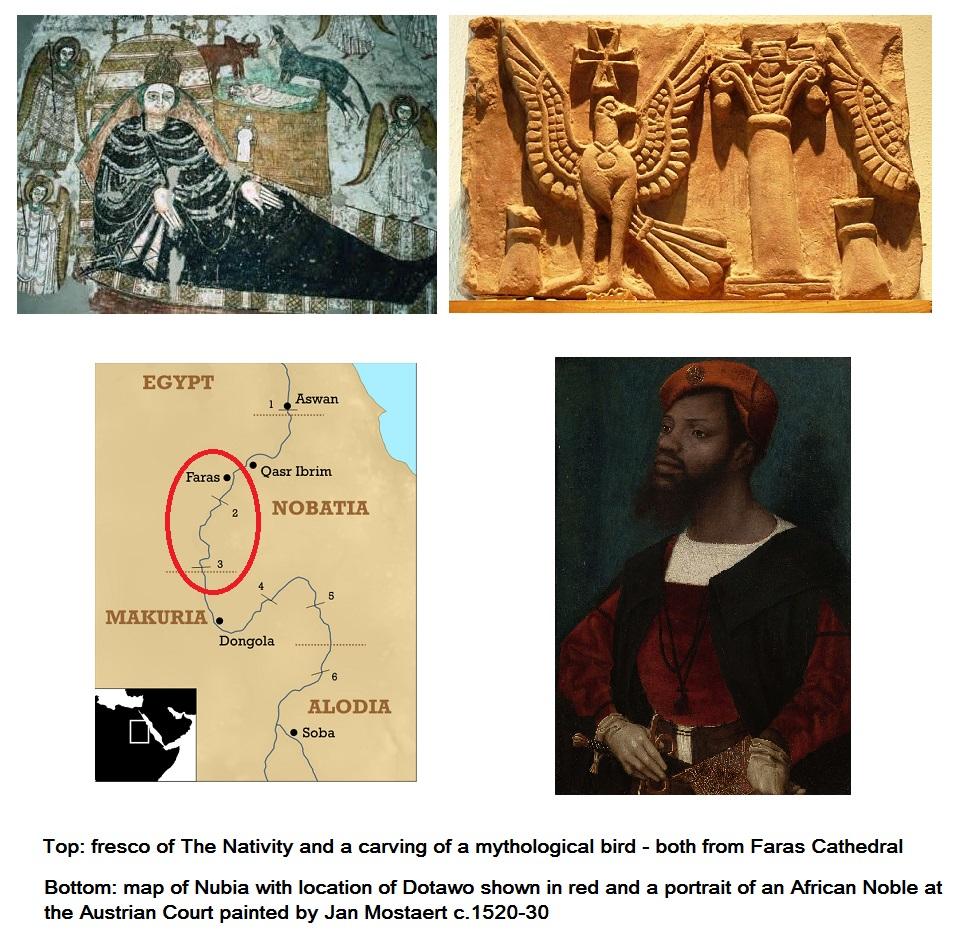DOTAWO – LOST CHRISTIAN KINGDOM OF MEDIEVAL AFRICA
Nubia is the name given to a group of medieval kingdoms that lay between the First and the Sixth Cataracts of the River Nile, an area which now straddles Southern Egypt and Northern Sudan. Christianity first reached these desert lands in the 4th Century AD, when ‘Marcus’ was consecrated ‘Bishop of Philae’, a Hellenic-Egyptian town on the Nubian border.
The early church chroniclers also recorded that the kingdom of Nobatia (northern Nubia) was converted in 545 AD, whilst Makuria (central Nubia) and Alodia (southern Nubia) were evangelised in 569 AD. At first the Coptic, Catholic and Orthodox churches were all active in Nubia but after the fall of Byzantine Egypt to Muslim Arabs in 642 AD most Nubian clergy transferred their allegiance to the Coptic Pope in Alexandria.
Though Nubia was now cut off from European Christendom, the independent Christian kingdoms of Nubia were quite capable of defending themselves. In 651 AD Amr ibn al-As, Arab conqueror of Egypt, sent an army into northern Nubia but this invasion was soundly defeated and a treaty known as ‘The Baqt’ was signed.
Partly a result of The Crusades, which kept Arab armies fully occupied for nearly two hundred years, The Baqt lasted until the 13th Century. However, the collapse of the Crusader states in the Holy Land led to a revival of Muslim power throughout the Middle East and North Africa. This renewed threat to their independence forced the rulers of northern Nubia to repair their cities’ walls, or move their subjects to more easily defended locations, and around this time the shadowy Kingdom of Dotawo emerges into history.
The little we know about Dotawo comes from Arab chronicles and for many years scholars even questioned the kingdom's existence. The doubters argued that Dotawo had not been an independent state at all but a vassal-colony of its neighbours or simply the Kingdom of Makuria by another name. However documents discovered in the 1960s contained a list of kings of Dotawo beginning with Moses-George, who reigned c.1144, and ending with Djoel who ascended the throne c.1484.
The heartland of these kings’ realm lay between the Second and Third Cataracts of the River Nile (i.e. from the modern Sudanese cities of Wadi Haifa in the north to Dongola in the south) and though Dotawo survived until the early 16th Century a change from Greek to Arabic names around 1300 AD shows increasing Arab influence following the breakdown of the Baqt Treaty.
The beginning of the end for Christian Nubia began during the reign of King Djoel when a confederation of Muslim, Arabic speaking tribes led by Abdullah Jamma ‘The Gatherer’ captured Dotawo’s southern neighbour Alodia. Abdullah’s victory was, however, fleeting because in 1504 his short-lived Abdallab Empire was conquered by a pagan people from southern Sudan known as The Funj. Their leader, Amara Dunqas, established his own empire with a new capital at Sennar.
Meanwhile, on Dotawo’s northern border, the balance of power was also shifting. In 1517 the Ottoman Turks replaced their Arab coreligionists as rulers of Egypt and in 1523, in a last effort to preserve his independence, Dunqas made Islam the official religion of his empire. Dotawo was now surrounded by Islamic states and cut off from Ethiopia, the only other Christian kingdom in Africa.
Though Portuguese explorers had sailed around the southern tip of Africa, and sent ambassadors to the court of the Ethiopian kings whom they believed were descended from the fabled ‘Prester John’ of medieval myth, they arrived too late to help beleaguered Dotawo. In 1543, with Portuguese help, the Ethiopians defeated a major Ottoman invasion but by this time the kingdom of Dotawo had already been absorbed into the Sultanate of Sennar.
The name of Dotawo was forgotten until the construction of the Aswan Dam in the 1960s. Prior to being flooded, two important Nubian towns were excavated by archaeologists. The dig at Qasr Ibrim discovered the aforementioned king-lists whilst a Polish team working at Faras uncovered an entire Christian cathedral.
Faras’ church had been completely buried by sand after the collapse of Dotawo at the end of the medieval period but this preserved some unique examples of Christian Nubian art. Today the cathedral’s rescued frescoes and carvings can be seen in the Polish National Museum in Warsaw, and the Sudan National Museum in Khartoum.
Incidentally, Djoel, the last recorded Christian king of Dotawo, was the inspiration for ‘Prometheus’, the fictional deposed Prince of Nubia, who appears in The Devil’s Band and its sequel The Devil’s Lance.
